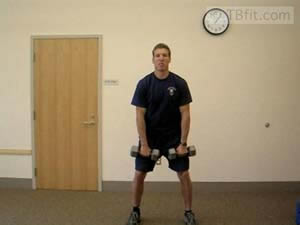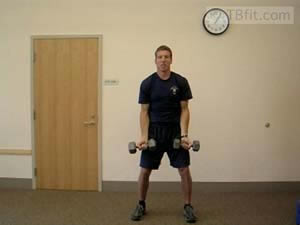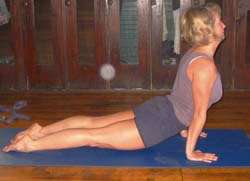Upper Body Exercises

Many Upper Body Exercises start from a strong standing position. We call this an 'Athletic Position'. It allows you to perform the exercises correctly and safely. See photo to the right.
To achieve an Athletic Position, check the following:
• Feet shoulder width apart - usually this is a little further apart than you think.
• Toes pointed just slightly outward
• Body weight is over heels, knees bent
• Strong core
• Chest forward, not down. Shoulders down and back (shoulders in photo are slightly slouched)
• Hips over feet, shoulders and ears over hips, no slouching or 'head forward' positioning.
Check your position every 2-3 reps. Use mirrors whenever possible.
Lower Body Exercises

Lower Body Exercises in this section range from easy to difficult. Pick exercises that work for your ability and your available equipment.
- When doing these exercises, be aware of some of these points:
- Knees should track over your feet throughout exercises - watch that they do not go past your toes or swing out to either side of your feet.
- Target soft landings when doing lunges or other movements
- Keep the chest up, do not slump. Be especially aware of this if you are holding dumbells.
- Work within your own comfortable range of motion - do not hyper extend or flex your knees.
- Maintain a strong core throughout range of motion
Core Exercises
Why strengthen your core? Your core or torso is your link between the upper body and the lower body. You can't transfer the strength of your lower body, the most powerful muscles in your body, to an oar in your hands with a weak core. Examples of ineffective power application caused by a weak core are when the body collapses as the oar comes to the body, or if you shoot your slide because the back can't handle the power generated from the legs. Leaning to one side in the boat can also be caused by weak core muscles.
The core muscles are located between the hips and chest. These muscles include the rectus abdominus, obliques (internal/external), transverse abdominus, quadratus lomborum, spinal erectors and the multifidus muscles. The core muscles are responsible for flexion and extension (front and back movement). They also move the body laterally (side to side). They rotate and twist the body (like sweep rowing), and they stabilize the body.
How do you strengthen the core? In order to strengthen the core you need to train all movements: flexion/extension, lateral, rotation, and stabilization. Training just one movement such as doing crunches only trains flexion/extension. You need to train all 4 areas to improve core strength.
How often should core training be performed? We recommend training the core 4x per week. An example of how to break up the days would be: Day 1 - flexion/extension, Day 2 - rotation, Day 3 - lateral, and Day 4 - stabilization. You can take a day off between Day 2 and 3. Another example would be to pair up two of the movements each day such as flexion/extension and rotation for Day 1. On Day 2 do lateral and stabilization exercises. You can then take a day off and then repeat sequence.
When doing any exercise, start off with simple exercises that are easy to do. Change up exercises every 3-4 weeks to make more challenging. Remember that core training is done to help prevent injuries, not create them so start easy and don't do an exercise if you are unsure how to do it.
Stretching

In this section you will find 2 stretching sequences, plus some individual stretches that we like to incorporate into our daily rowing routine.
Stretch 2-3 times weekly to maintain flexibility and range of motion, but stretch daily to improve flexibility.
Read these guidelines, then use one of our Stretching Routines. They were developed by rower and yoga instructor Sonia Witte. Once you become familiar with it, it will take you about 15 minutes to complete.
Guidelines
Warm up aerobically for 5 - 10 minutes before you stretch
• Stretching should not be painful; avoid poses that hurt your joints or stretch you too far
• Uber-flexibility is not our goal, just developing and maintaining a good range of motion, especially as we get older.
• Abandon your competitive mind set during stretching
• Do not take a pose so far that you feel pain or lose the form of the pose. If you feel pain, come slowly out of the pose by reversing how you got into it.
• Protect your spine - in forward bends make sure the bend comes from the hip joint not the lower back, do not let the spinous processes of your vertebrae protrude.
• Be barefoot to allow you to get the best grip on the floor, bring mind-body awareness to the periphery of your body, and understand your posture from the base.
• Work to create space between the joints.
• Take enough time to come into each pose slowly before going to your maximum stretch.
• Release the poses slowly and with control, generally moving backward through the steps that got you into the pose.
• Learn the poses in "Sun Salutation" individually before linking them into a "Vinyasa" (moving sequence of poses).
• Learn your body, and work with areas which are your limitations rather than reinforcing the flexibility of those areas which are already quite loose.
If you can, take a yoga class with a qualified instructor from time to time to keep track of alignment issues specific to your body, and introduce you to new poses.